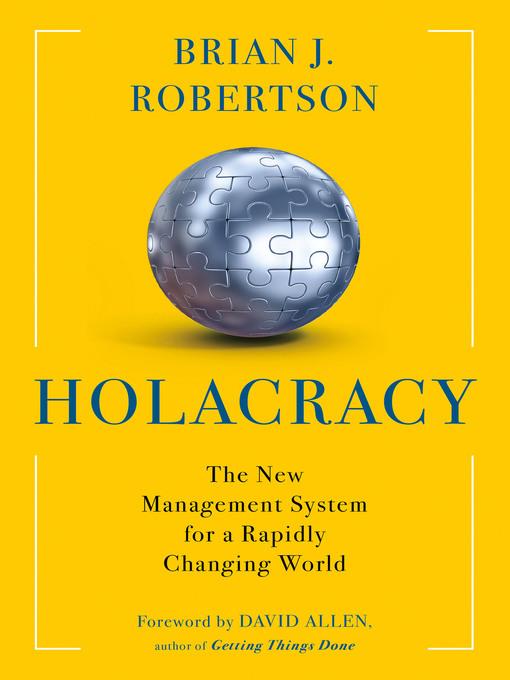
Holacracy
The New Management System for a Rapidly Changing World
فرمت کتاب
ebook
تاریخ انتشار
2015
نویسنده
Brian J. Robertsonناشر
Henry Holt and Co.شابک
9781627794299
کتاب های مرتبط
- اطلاعات
- نقد و بررسی
- دیدگاه کاربران
نقد و بررسی

March 23, 2015
As this illuminating business manual relates, HolacracyOne founder Robertson started his company in order to help other leaders prepare their companies for growth and scale. According to him, businesspeople need to be able to react promptly and improve quickly, and the current model—top-down; “predict-and-control”—is not fast or agile enough. The “Holacracy” technique was created to address this need. It comprises a “constitution” for the redistribution of power within the company, a revamp of company structure and hierarchy, an overhauled decision-making process, and a revised model for meetings and communication. The book accordingly leads readers through the process of redistributing authority and improving decision-making, which involves shifting from personal leadership to constitutionally-derived power. Backed up by contributions from Zappos CEO Tony Hsieh and other business luminaries, this is a practical, step-by-step guide to putting in place a new, unfamiliar structure, one where the executive retains autonomy and individual authority while allowing others to lead highly structured meetings and systematic decision-making. This approach requires an all-in; it’s most likely to find its readership with those who are ready to make a huge leap. B&w illus. Agent: Lisa Queen, Queen Literary Agency.

April 15, 2015
An introduction to a new kind of corporate management system modeled on the self-organizing structures of organic matter. Management consultant Robertson, founder of HolacracyOne, offers a primer on the system he pioneered, accompanied by procedures required for its adoption and the outline of a training program. The author's program incorporates elements of traditional organization theory as well as inputs from David Allen, who created the "Getting Things Done" time management system. As opposed to a hierarchy, a "holarchy" is analogous to complex, multilayered systems like those which the author writes are "all around us in the way nature organizes itself." He points to the relationship between cells and their containing organs, which "simultaneously honor autonomy and enable self-organization at every level within." The author argues that his system will enhance productivity and reduce time spent in unwieldy meetings, and he provides ways to help overcome resistance to the new procedures he recommends and the inevitable fears roused by the adoption of these radical innovations. Robertson expects that such structures will enable individuals to define roles for themselves within the overall framework of corporate governance. With the use of his system, organizations can reduce the impacts of personal, emotion-driven conflicts and political infighting. He outlines how each autonomous layer should deliberate and define choices for action, within and between each element of his proposed assembly. Robertson also describes the mechanics of agenda construction and the roles of participants. The primacy allotted to choice and deliberation seems to undermine the author's intent to imitate the form of complex natural structures, which, thus far, have not provided evidence of either. Nor has there been found a formal structure that can substitute for transformative individuals like Bill Gates, Andy Grove, or Steve Jobs. Despite some intriguing nuggets scattered throughout, this book is a booster piece seemingly based on science but proposing a remedy for not adequately specified conditions.
COPYRIGHT(2015) Kirkus Reviews, ALL RIGHTS RESERVED.

May 15, 2015
Robertson's first book gives an overview of Holacracy, a management system that purports to deal with a rapidly changing environment. His premise is that the role of management is to organize the work, not the people, through the development of process. The author echoes the opinion of Eric D. Beinhocker (The Origin of Wealth) that evolution is an algorithm, and that trial and error is at the hub of new processes. Robertson, like others including Tom Peters (In Search of Excellence), is an advocate of an inverted pyramid, or at least a flattened organization. Organizational behaviorists may find critical flaws (e.g., inverted pyramids defy gravity, ISO standards may be difficult to achieve, and entropy is as much a fact of life as evolution). From a philosophical perspective, Holacracy is a closed system; the difficulty is that such systems often experience challenges when dealing with outside factors. VERDICT While Robertson freely shares his blueprint for creating a holacratic organization, including references to his organization's website, he believes that the coaching his organization provides makes the transition easier. Buy the book only after perusing Holacracy.org.--Steven Silkunas, Fernandina Beach, FL
Copyright 2015 Library Journal, LLC Used with permission.

May 15, 2015
Any new business term deserves attentionand close examination. Former software executive Robertson, having the luxury of building and running a business, has invented a new management system that in essence uses a constitution, not a suite of leaders, to guide an organization. That letting go of authority might be one of the single biggest barriers to implementing this philosophy in any business, big or small. On the other hand, Robertson's new structure for meetings, from a check-in round to integrative decision making (that is, ensuring that tensions get resolved), will appeal. It does get a bit messy in the narrative; with abstruse and abstract terms like governance and processes, and without enough real-life case histories, the language veers toward the dense and hard to understand. He does backtrack on his original stanceyou must adopt holacracy in total or not at allby introducing holacracy lite: a way to incorporate some of the best features of his system, like meetings. No shades of 1984, yet it needs a few more tangibles.(Reprinted with permission of Booklist, copyright 2015, American Library Association.)

























دیدگاه کاربران